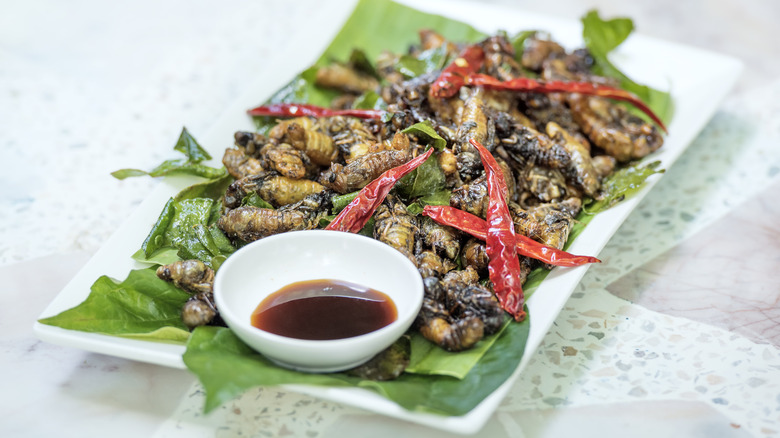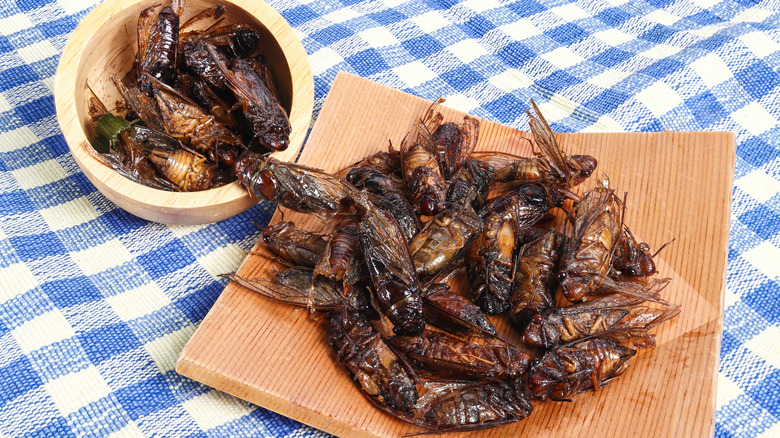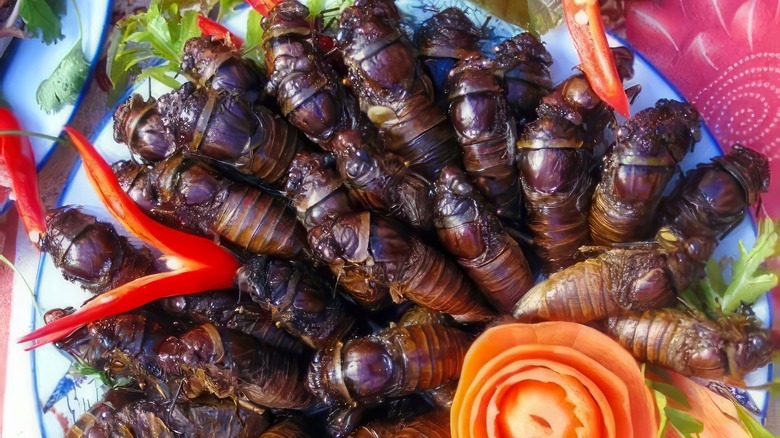The One Thing You Should Consider Before Eating Cicadas
2024 will be remembered as a banner year by entomophagists – people who eat insects. That's because, for the first time since 1803, two separate broods of cicadas simultaneously emerged from underground by the literal trillions. From the Midwest through to the Southeast United States, the winged critters surfaced in order to fulfill their biological destinies during mating season. They're notorious for their exceptionally loud, buzzing mating call sounds but lesser known for the fact that they are also edible, very nutritious, and quite tasty too.
Cicadas were traditionally eaten by Native Americans, enjoyed in ancient Rome and Greece, and are still popular in Asia and Africa. These 'shrimp of the land,' as they are sometimes referred to, have had numerous cookbooks written about them, including a recipe by Frank's Red Hot, which, as you might expect, features them eaten with plenty of hot sauce. The snack-worthy bugs are a good source of complete protein and antioxidants; plus, they are low in carbohydrates, fat, and cholesterol.
The insects are fairly innocuous aside from the clamorous noise of their chorus. They don't bite or sting, and since they're not venomous or poisonous, they are a reliable food source.
The one thing you should consider before eating cicadas, however, is their possible exposure to heavy metals. Since they spend the majority of their lives being subterranean (13-years for Brood XIX and 17-years for Brood XIII), cicadas may be contaminated by the soil with high levels of mercury and other toxins.
Eating cicadas may expose you to mercury and allergens
Cicadas are bioaccumulators, which means that toxic substances they are exposed to build up in their bodies. Toxins from industrial factories and farm run-off spread through air and water, polluting the soil that the insects burrow in — and the tree roots they feed on. When you eat plants or animals that contain mercury, it can accumulate within your body as well. Mercury is a neurotoxin that can harm your nervous and cardiovascular systems, as well as your brain and other organs.
Although eating a moderate amount of cicadas won't likely cause serious damage, 2024's double brood emergence is expected to be contaminated with especially high mercury levels. Similar levels in swordfish, shark, and tuna have warranted consumer advisories. While it's a risk you can easily avoid by reading canned tuna labels, wild insects, unfortunately, do not come with such convenient warnings. For this reason, children (for whom mercury is especially harmful) and people who are pregnant or lactating should avoid eating cicadas (per the Cleveland Clinic).
Another consideration to keep in mind is allergens. Cicadas are arthropods closely related to crustaceans like lobsters, crab, crayfish, and shrimp. The FDA has issued a warning to avoid eating cicadas if you are allergic to seafood, because you may suffer a similar reaction. The cause is a muscle protein called tropomyosin, which, when ingested by someone allergic to it, can trigger mild to severe reactions ranging from hives to anaphylaxis shock (per FDA).
How to clean and cook cicadas
Cicadas are usually found in woodlands, but given the massive number of 2024's appearance, you're likely to see them in parks and other natural settings. It's important to only gather them from clean places where the groundwater and soil have not been contaminated by pesticides. Similarly, it's a good idea to not pluck them near older homes, which may have shed lead from old paint.
For the tastiest cicadas, look for them late at night or early in the morning. That's when newly molted tenerals rise from the dirt to begin climbing trees. These plump youngsters will be at their most tender before their outer exoskeletons begin to harden. Cicadas can be dropped directly into boiling water, but a more humane treatment is to freeze them before cooking. They should be washed before eating, and it's best to boil off any microbes or parasites.
Cicadas are described as being shrimpy with nutty notes of almond and asparagus. Try them battered and deep-fried like popcorn shrimp, sauteed in butter like scampi, tossed into stir-fries, grilled on skewers, tucked into tacos, or topped on pizzas. They also make for a great bar snack. In Zimbabwe, the country that drinks the most alcohol in the world, a similar snack made from salted mopane worms is enjoyed with beer. Treat them like spicy beer tempura grasshoppers, aka, bug fries, or sprinkle them with Old Bay seasoning and serve with your favorite dip.



